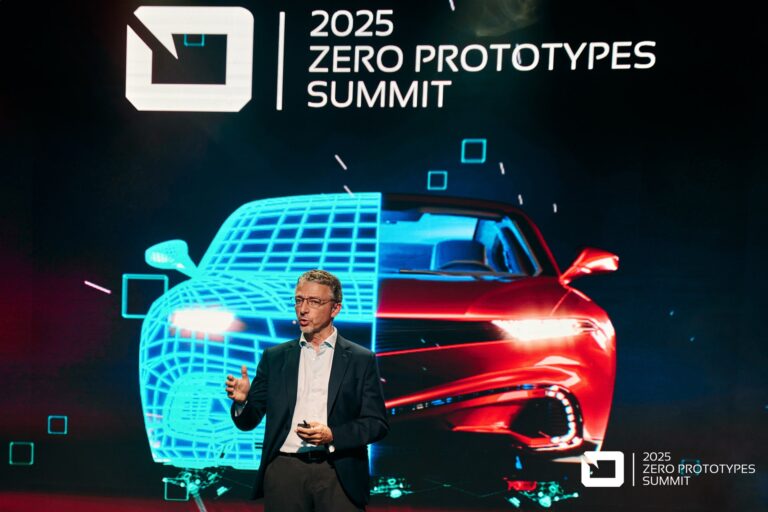Held on May 13-15 in Udine, Italy, this year’s VI-grade Zero Prototypes Summit featured two days of high-level content and demonstrated a stronger acceptance than ever before of simulation-led development among OEMs, with many attendees eager to explore their options and learn from one another
The VI-grade Zero Prototypes Summit 2025 kicked off with a networking dinner on Tuesday, May 13, during which the company unveiled its latest 6DOF motion platform, the HexaRev. This new system represents the third step in VI-grade’s roadmap toward full-spectrum simulation, after the Compact FSS Simulator launched in 2023 and the HyperDock launched in 2024. It’s the result of “hundreds of conversations with customers,” said Guido Bairati, the company’s MD.
“We started with the workspace available on a hexapod. One of the issues is that when you’re at maximum lateral displacement, you have no longitudinal displacement left,” he explained. “In a car, you might still have some longitudinal movement even at maximum lateral displacement, so a different architecture was needed.”
The HexaRev also operates almost silently, thanks to the removal of mechanical components such as belts and gears. This is particularly valuable when developing electric vehicles, where a noisy simulator can distort the experience. Ennio Salvati, vehicle dynamics performance manager at Forseven, pointed out that under heavy braking, the hexapod’s sound interferes with his perception.
“I’m not interested in NVH; my focus is dynamics, so I’m curious to experience the silence. I usually drive [in the simulator] with earplugs,” he said.
Bairati added that it’s not unusual for test drivers to use headphones – a practice that doesn’t reflect real-world driving.
Looking ahead, Bairati said the new simulator could act as the upper stage of the cable simulator, giving developers the option to start with a 6DOF platform and later upgrade to a 9DOF system.
As the industry steadily shifts toward driver-in-the-loop (DIL) development, many OEMs are carefully weighing the investment in simulator technology. The annual summit provides a valuable opportunity for developers to exchange ideas and experience the technology firsthand.
OEMs explore simulation future
One company considering the leap to simulator-based analysis is Honda America. It already operates a desktop simulator, which has served as a first step. Now, it is preparing to advance further.
“At Honda, we realize that zero prototypes is the future – regardless of whether we adopt driving simulator technology or not. It’s a necessity to enable the future,” said Nathan Benya, an engineer at Honda R&D Americas.
He noted that Honda’s teams in Japan and Europe already use DiL setups, providing expertise and experience to help smooth the transition. “We’re following their lead,” he said.
Benya also observed that several products at the summit could support their roadmap toward full DiL simulation: “We’re building our foundation on ride and handling, with the intention of expanding to the rest of the organization. The event gives me insight into how it’s applied cross-functionally elsewhere.”
Also attending the summit to expand their knowledge were Olof Pawlowski, test engineer and feature leader, handling, and Magnus Ahlstedt, test engineer and feature leader ride comfort, at Volvo Trucks. Although they already use some simulation tools, they described themselves as “newbies” to DiL. The summit offered them a chance to explore different systems as they consider a future purchase. They collected insights from peers on both the benefits and limitations of simulators, and on how to make informed equipment choices. Specifically, they’re evaluating the Compact FSS and the DiM400.
“It’s not so much about fine-tuning from my perspective – it’s more about scanning options to ensure the outer layers are right,” explained Ahlstedt. “It could be very useful to test multiple variations in a much simpler way than building a physical prototype.”
Pawlowski added, “Reducing prototypes isn’t the goal – it’s about testing differently. It would be great to replace some prototypes, because we often complain that we don’t have enough [prototype] trucks. With this, we could produce specifications at the press of a button.”
Truck complexity is growing, as are the demands placed on development teams. That complexity introduces new issues, and getting physical prototypes up and running is increasingly difficult.
“We want to understand if this is the right direction for us. We’ve just started a cross-functional team to evaluate the possibilities,” said Ahlstedt.
The summit attracted more than 300 in-person attendees and 1,500 online participants, representing almost 100 companies, including 24 major automotive OEMs, 17 Tier 1 suppliers and engineering service providers, and six academic and research institutions. Presentations were delivered by the likes of Alpine, Aston Martin Lagonda, Lamborghini, Stellantis and Honda R&D, to name a few.
More info on the summit at this link.


